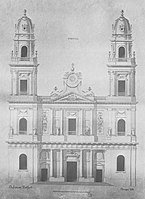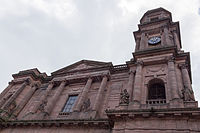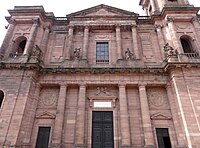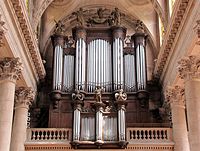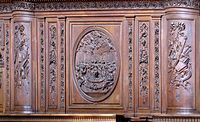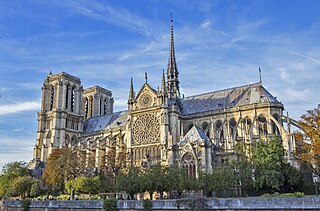
Notre-Dame de Paris, referred to simply as Notre-Dame, is a medieval Catholic cathedral on the Île de la Cité, in the 4th arrondissement of Paris. The cathedral, dedicated to the Virgin Mary, is considered one of the finest examples of French Gothic architecture. Several of its attributes set it apart from the earlier Romanesque style, particularly its pioneering use of the rib vault and flying buttress, its enormous and colourful rose windows, and the naturalism and abundance of its sculptural decoration. Notre Dame also stands out for its musical components, notably its three pipe organs and its immense church bells.

Chartres Cathedral, also known as the Cathedral of Our Lady of Chartres, is a Roman Catholic church in Chartres, France, about 80 km southwest of Paris, and is the seat of the Bishop of Chartres. Mostly constructed between 1194 and 1220, it stands on the site of at least five cathedrals that have occupied the site since the Diocese of Chartres was formed as an episcopal see in the 4th century. It is in the High Gothic and Romanesque styles, with a Flamboyant north spire.
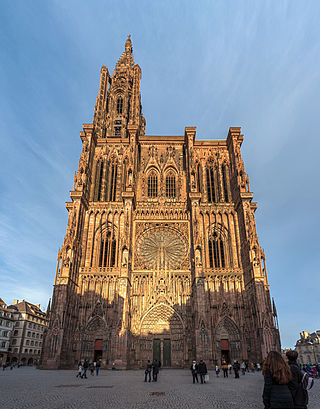
Strasbourg Cathedral or the Cathedral of Our Lady of Strasbourg, also known as Strasbourg Minster, is a Catholic cathedral in Strasbourg, Alsace, France. Although considerable parts of it are still in Romanesque architecture, it is widely considered to be among the finest examples of Rayonnant Gothic architecture. Architect Erwin von Steinbach is credited for major contributions from 1277 to his death in 1318, and beyond through his son Johannes von Steinbach, and his grandson Gerlach von Steinbach, who succeeded him as chief architects. The Steinbachs's plans for the completion of the cathedral were not followed through by the chief architects who took over after them, and instead of the originally envisioned two spires, a single, octagonal tower with an elongated, octagonal crowning was built on the northern side of the west facade by master Ulrich von Ensingen and his successor, Johannes Hültz. The construction of the cathedral, which had started in the year 1015 and had been relaunched in 1190, was finished in 1439.

Guebwiller is a commune in the Haut-Rhin department in Grand Est currently in north-eastern France. It was a sub-prefecture of the department until 2015.
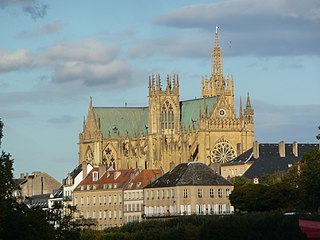
Metz Cathedral, otherwise the Cathedral of Saint Stephen, Metz, is a Roman Catholic cathedral in Metz, capital of Lorraine, France. It is dedicated to Saint Stephen. First begun in the early 14th century, it was joined with the collegiate church of Notre-Dame in the mid-14th century, and given a new transept and late Gothic chevet, finished between 1486 and 1520. It is the cathedral of the Roman Catholic Diocese of Metz as the seat of the bishops of Metz. The cathedral treasury displays the collection, assembled over 1,000 years, of the bishopric of Metz, including paraments and items used for the Eucharist.

Soissons Cathedral is a Gothic basilica church in Soissons, France. It is the seat of the Bishop of Soissons, Laon, and Saint-Quentin. The construction of the south transept was begun about 1177, and the lowest courses of the choir in 1182.

Nantes Cathedral, or the Cathedral of St. Peter and St. Paul of Nantes, is a Roman Catholic Gothic cathedral located in Nantes, Pays de la Loire, France. Construction began in 1434, on the site of a Romanesque cathedral, and took 457 years to finish in 1891. It has been listed since 1862 as a monument historique by the French Ministry of Culture.

Located at 6, rue Notre-Dame-des-Victoires, in the 2nd arrondissement of Paris, The Basilica of Notre-Dame-des-Victoires is one of ten minor basilicas located in the Île-de-France region of France. It was begun as an Abbey church, and constructed between 1629 and 1740 in the French classical style. Its name was given by King Louis XIII, who dedicated it to his victory over the Protestants at La Rochelle in 1628 during the French Wars of Religion. Notre-Dame-des-Victoires is famous for the ex voto offerings left there by the faithful. Over 37,000 devotional plaques, silver and gold hearts, as well as military decorations, have been left at the basilica. The closest Métro station is 'Bourse'.

Peter Thumb was an Austrian architect and master builder whose family came from Bezau, Vorarlberg, in the westernmost part of Austria. He was active in Baden, the Black Forest, Alsace, Upper Swabia, on and around Lake Constance, and in Switzerland. He is best known for his Rococo architecture, mainly in Southern Germany. Outstanding examples of his work include the pilgrimage church at Birnau on Lake Constance and the monastery library at the Abbey of Saint Gall, Saint Gallen, Switzerland.

The Church of St. James on Coudenberg is a Roman Catholic church located on the historic Place Royale/Koningsplein, in the Royal Quarter of Brussels, Belgium. It is dedicated to Saint James.

The Église Notre-Dame de l'Assomption is a Roman Catholic parish church of the town of Rouffach in southern Alsace. It is one of the largest medieval churches in the Haut-Rhin département of France. The church is also known as Saint-Arbogast Church . It lies on the "Route Romane d'Alsace". Although work started in the 11th century and was carried on with interruptions until 1870, the building remains unfinished.

The Route Romane d'Alsace is a tourist itinerary designed by the Association Voix et Route Romane to link both the well-known and the more secret examples of Romanesque architecture of Alsace, in an itinerary of 19 stages, linking churches, abbeys and fortresses, that range from the first Romanesque structures of Alsace at the abbey church of Saint Trophime, Eschau, into the 13th century, and the beginning of Gothic architecture in Alsace. From north to south, the Route Romane d'Alsace traverses the Bas-Rhin and the Haut-Rhin, passing through:

The Église Saint-Martin is a Roman Catholic church located in Colmar, Haut-Rhin, France. It is in the principal Gothic architectural style. Because of its past as a collegiate church, is also known als Collégiale Saint-Martin, and because of its large dimensions, as Cathédrale Saint-Martin, although Colmar had never been the seat of a bishopric.
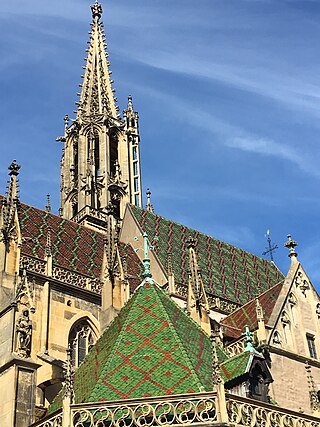
The Collégiale Saint-Thiébaut in Thann, Haut-Rhin is one of the most ornate Gothic churches in the whole Upper Rhenish region. Of its 76 meters high spire, it is said that "The spire of Strasbourg is the highest, the spire of Freiburg is the broadest but the spire of Thann is the prettiest." In spite of its name, the church is actually dedicated to Saint-Ubald, of which it keeps a finger as a relic. It is listed as a Monument historique since 1841 by the French Ministry of Culture.

St. Peter and St. Paul's Church of Wissembourg is frequently, but incorrectly, referred to as the second largest Gothic church of Alsace after Strasbourg Cathedral. However, the building, with its interior ground surface area of 1,320 square metres (14,200 sq ft) most probably is the second largest Gothic church in Bas-Rhin which is one of the two departments of the Alsace region. The former abbey church (abbatiale) of Wissembourg's famous Benedictine abbey now serves as the main Roman Catholic parish church of the town.

Notre-Dame-de-Lorette is a Roman Catholic Church located in the 9th arrondissement of Paris, It was built between 1823 and 1836 in the Neo-classical architectural style by architect Louis-Hippolyte Lebas, in a neighbourhood known as the New Athens, for its many artistic and scholarly residents in the 19th century, including George Sand, Pierre-Auguste Renoir, and Alexandre Dumas. While the exterior is classical and austere, the church interior is known for its rich collection of paintings, sculpture, and polychrome decoration.

Notre-Dame de Reims, , is a Roman Catholic cathedral in the French city of the same name, the archiepiscopal see of the Archdiocese of Reims. The cathedral was dedicated to the Virgin Mary and was the traditional location for the coronation of the kings of France.
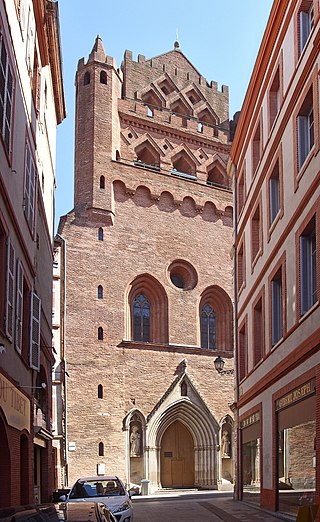
Notre-Dame du Taur is a Roman Catholic church located in Toulouse, France. According to legend, the edifice was built on the exact spot where the body of Saint Saturnin (Sernin), patron saint of Toulouse, became detached from the bull that dragged the martyr to his death. The church stands in the rue du Taur between the Capitole and the Basilica of St. Sernin. It has been classified as a historic monument since 1840.

Saint Trophimus' Church is a Romanesque church in Eschau, a small town in the suburbs of Strasbourg, the historical capital of Alsace. The church is dedicated to Trophimus of Arles.

Notre-Dame de l′Assomption is a Catholic parish church in the small town of Bergheim, in the Haut-Rhin department of France. It is classified as a Monument historique since 1985.


